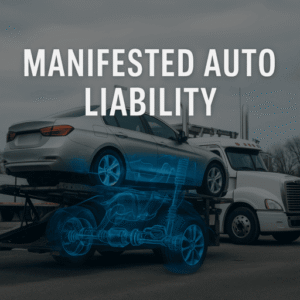Manifested Auto Liability Coverage: Why Auto Haulers Can’t Afford to Ignore It
By Al Bagiro, CPCU, RPLU
At Cogo Insurance, we talk to auto haulers every day who think they’ve “covered all their bases,” only to find themselves exposed when a claim arises for damages discovered weeks or months after delivery.
That’s where manifested auto liability coverage — sometimes called discovery trigger coverage — comes in.
Just like diminished value and constructive total loss (CTL), which I covered in another article here on Cogo’s site, manifested auto coverage addresses a very real, and often misunderstood, risk unique to your business.
If you’re in the business of transporting high-value cars like BMWs, Porsches, Lincolns, or even specialty classics, understanding how manifestation triggers work — and making sure your policy includes them — can mean the difference between a paid claim and a devastating out-of-pocket loss.

What Is Manifested Auto Liability Coverage?
Most liability and cargo insurance policies include language defining what “triggers” coverage. In other words, what event activates the insurer’s obligation to pay a claim?
In standard policies, the trigger might be:
-
- When the damage occurred (even if no one noticed at the time)
-
- When the injury or damage was discovered (manifested)
-
- Or when the insured was actually exposed to the risk
Manifested auto liability coverage specifically applies when the damage or injury becomes known (manifests) during the policy period, even if the original accident happened before the policy began.
This makes it fundamentally different from typical “occurrence-based” coverage, which only applies if the accident itself happened during the policy period — regardless of when it was discovered.
Why Manifestation Matters for Auto Haulers
You’ve seen it happen:
You deliver a car — it looks fine, no one notices anything wrong. Weeks later, the owner discovers a warped panel, cracked undercarriage, or a drivetrain issue clearly tied back to improper securement during transit.
If you don’t have a manifestation trigger in your policy, your insurer could deny the claim outright if the actual accident (loading, securing, or shifting in transit) happened before your current policy began — even though you didn’t know about it.
This is especially risky if:
-
- You’ve recently switched carriers
-
- You move high-value vehicles prone to owner scrutiny
-
- You handle long-term storage or multi-leg transport
For cars like a $110,000 Porsche Panamera, a $90,000 Lincoln Navigator Black Label, or a pristine $140,000 BMW M8, even small undetected damage can result in massive claims once discovered.
A Realistic Example
Let’s say you’re hauling a 2022 BMW 7 Series worth $100,000 in March. During transit, it’s improperly secured, and the underbody is scraped — but no one notices when the car is delivered in April.
In May, the owner takes it to a dealer for service, and the mechanic discovers the damage, which clearly happened during transit.
If your policy only covers damage that “occurred” during the policy period — and the accident happened under your old policy — you’re on the hook.
But if you have a manifested auto liability clause, the discovery in May triggers coverage, even though the accident itself occurred before the current policy began.
How Manifestation Compares to Other Coverage Triggers
| Trigger Type | When Coverage Applies |
|---|---|
| Occurrence Trigger | When the accident or damage occurs (even if no one notices) |
| Exposure Trigger | When the insured is exposed to harmful conditions |
| Injury-in-Fact Trigger | When the injury or damage physically happens |
| Manifestation Trigger | When the injury or damage is discovered |
Having an auto hauler’s cargo liability policy (or suite of policies) that explicitly addresses all three major risks — constructive total loss (CTL), diminished value (DV), and manifested auto liability — would indeed represent a best-in-class risk management approach for an auto hauler.
Here’s why:
Why a Policy With All Three Clauses Is Ideal
Constructive Total Loss (CTL):
Protects you when the cost of repairing a damaged vehicle is economically impractical compared to its actual cash value (ACV). High-value cars like BMWs, Porsches, Lincolns, and exotics can hit CTL thresholds even for moderate damages because OEM parts and specialized labor inflate repair costs. Without CTL language, you risk underpayment or denial if a repairable-but-not-economical vehicle is treated as a partial loss.
Diminished Value (DV):
Protects you when an owner claims that, even after flawless repairs, their vehicle’s resale value has dropped due to its accident history showing up on Carfax. Without DV coverage, these claims can hit your pocket directly — especially when you’re hauling $100k+ vehicles whose owners scrutinize every dollar of market depreciation.
Manifested Auto Liability:
Protects you when damage isn’t discovered until after delivery — which happens often in this industry. Without a manifestation trigger, insurers can deny claims because the actual incident occurred before the current policy period, even though you and the customer didn’t notice it at the time.
Why Most Haulers Don’t Have All Three
-
- Cost: Adding these enhancements may slightly increase premiums, though not exorbitantly if written properly.
-
- Complexity: Most agents, brokers and carriers don’t take the time to customize coverage for the unique exposures of auto haulers.
-
- Awareness: Some haulers and agents simply don’t know these are available or assume their standard cargo policy is “good enough.”
Cogo Insurance is different – we know trucking, we know auto haulers, and we know insurance. Contact us with details about your company, and we will make it happen for you.

